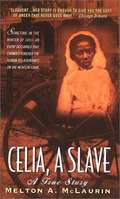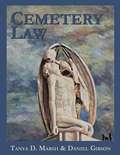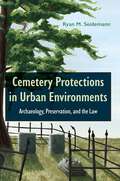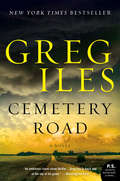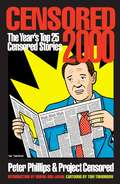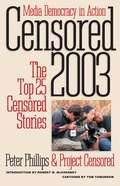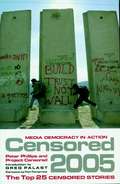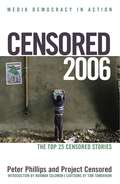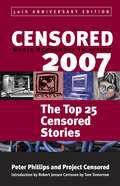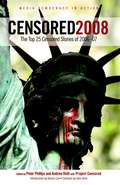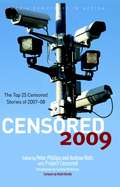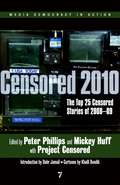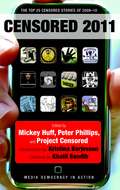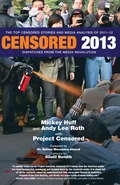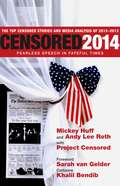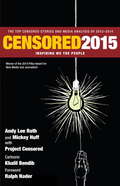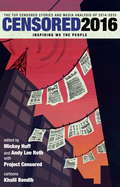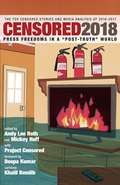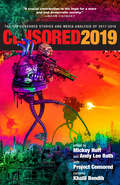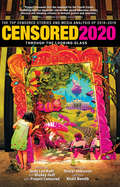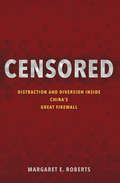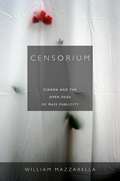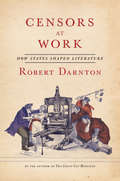- Table View
- List View
Celia, A Slave
by Melton A. MclaurinIn 1850, fourteen-year-old Celia became the property of Robert Newsom, a prosperous and respected Missouri farmer. For the next five years, she was cruelly and repeatedly molested by her abusive master--and bore him two children in the process. But in 1855, driven to the limits of her endurance, Celia fought back. And at the tender age of eighteen, the desperate and frightened young black woman found herself on trial for Newsom's murder--the defendant in a landmark courtroom battle that threatened to undermine the very foundations of the South's most cherished institution. Based on court records, correspondences and newspaper accounts past and present, Celia, A Slave is a powerful masterwork of passion and scholarship--a stunning literary achievement that brilliantly illuminates one of the most extraordinary events in the long, dark history of slavery in America.
Cemetery Law: The Common Law of Burying Grounds in the United States
by Tanya D. Marsh Daniel GibsonConcerns about the cost and environmental consequences of the “traditional” American model of burial—embalming, casket, vault, single perpetual grave—are prompting the first significant challenges to American disposition practices since the Civil War. Burial itself is even being challenged—the popularity of cremation has exploded in recent decades and it will soon become the dominant practice. Americans eager to innovate in deathcare find that the law—still heavily rooted in 17th century English, Protestant practices and beliefs—is ill-equipped to adapt. Cemetery law in the United States has changed little in the past 200 years, but the challenges to our disposition practices are so widespread and significant that it will soon have no choice. It is unimaginable that we will start with a clean slate. Instead, the law will, as it always does in a common law system, slowly evolve from its current form. Before we can change the law, we must first understand it. This book is designed to help jumpstart that process by outlining the history, structure, and doctrines of the common law of burying grounds in the United States.
Cemetery Protections in Urban Environments: Archaeology, Preservation, and the Law
by Ryan M. SeidemannA history and practical analysis of legal protections for urban landscapes of grieving and cultural memory In this book, Ryan Seidemann brings together the areas of burial legislation, urban planning, history, biological anthropology, and archaeology to illuminate the role of the law in the protection and preservation of cemetery spaces. Providing a history and analysis of cemetery site protections in the United States, Seidemann explains current legal and law enforcement realities and discusses how to prevent future damage and development in urban burial grounds. Seidemann shows that while legal measures are put in place to honor the dead and uphold the maintenance of burial sites, these laws are unevenly enforced and can be ineffective, often failing to protect cemeteries important to people who do not have the power to fight developers. Offering case studies from his own work in Louisiana, Seidemann demonstrates that priorities of urban planning and private property are often emphasized at the expense of local communities. Cemetery Protections in Urban Environments illustrates the knowledge and specialization that both archaeology and the legal world contribute to the preservation of burial locations. This book provides a concise overview of the legal tools that exist and the tools that are needed to preserve such sites, useful for researchers and practitioners in a variety of fields.
Cemetery Road: A Novel
by Greg IlesSometimes the price of justice is a good man’s soul.The #1 New York Times bestselling author of the Natchez Burning trilogy returns with an electrifying tale of friendship, betrayal, and shattering secrets that threaten to destroy a small Mississippi town. <P><P>When Marshall McEwan left his Mississippi hometown at eighteen, he vowed never to return. The trauma that drove him away spurred him to become one of the most successful journalists in Washington, DC. But as the ascendancy of a chaotic administration lifts him from print fame to television stardom, Marshall discovers that his father is terminally ill, and he must return home to face the unfinished business of his past. <P><P>On arrival, he finds Bienville, Mississippi very much changed. His family’s 150-year-old newspaper is failing; and Jet Turner, the love of his youth, has married into the family of Max Matheson, one of a dozen powerful patriarchs who rule the town through the exclusive Bienville Poker Club. To Marshall’s surprise, the Poker Club has taken a town on the brink of extinction and offered it salvation, in the form of a billion-dollar Chinese paper mill. But on the verge of the deal being consummated, two murders rock Bienville to its core, threatening far more than the city’s economic future. <P><P>An experienced journalist, Marshall has seen firsthand how the corrosive power of money and politics can sabotage investigations. Joining forces with his former lover—who through her husband has access to the secrets of the Poker Club—Marshall begins digging for the truth behind those murders. But he and Jet soon discover that the soil of Mississippi is a minefield where explosive secrets can destroy far more than injustice. <P><P>The South is a land where everyone hides truths: of blood and children, of love and shame, of hate and murder—of damnation and redemption. The Poker Club’s secret reaches all the way to Washington, D.C., and could shake the foundations of the U.S. Senate. But by the time Marshall grasps the long-buried truth about his own history, he would give almost anything not to have to face it. <P><b>A New York Times Bestseller</b>
Censored 2000: The Year's Top 25 Censored Stories
by Peter Phillips Project Censored Mumia Abu-Jamal Tom TomorrowThe yearly volumes of Censored, in continuous publication since 1976 and since 1995 available through Seven Stories Press, is dedicated to the stories that ought to be top features on the nightly news, but that are missing because of media bias and self-censorship. The top stories are listed democratically in order of importance according to students, faculty, and a national panel of judges. Each of the top stories is presented at length, alongside updates from the investigative reporters who broke the stories.Beyond the Top 25 stories, additional chapters delve further into timely media topics: The Censored News and Media Analysis section provides annual updates on Junk Food News and News Abuse, Censored Déjà Vu, signs of hope in the alternative and news media, and the state of media bias and alternative coverage around the world. In the Truth Emergency section, scholars and journalists take a critical look at the US/NATO military-industrial-media empire. And in the Project Censored International section, the meaning of media democracy worldwide is explored in close association with Project Censored affiliates in universities and at media organizations all over the world.A perennial favorite of booksellers, teachers, and readers everywhere, Censored is one of the strongest life signs of our current collective desire to get the news we citizens need--despite what Big Media tells us.
Censored 2003: The Top 25 Censored Stories
by Robert W. Mcchesney Peter Phillips Project Censored Tom TomorrowThe yearly volumes of Censored, in continuous publication since 1976 and since 1995 available through Seven Stories Press, is dedicated to the stories that ought to be top features on the nightly news, but that are missing because of media bias and self-censorship. The top stories are listed democratically in order of importance according to students, faculty, and a national panel of judges. Each of the top stories is presented at length, alongside updates from the investigative reporters who broke the stories.
Censored 2005: The Top 25 Censored Stories
by Greg Palast Peter Phillips Project Censored Tom TomorrowThe yearly volumes of Censored, in continuous publication since 1976 and since 1995 available through Seven Stories Press, is dedicated to the stories that ought to be top features on the nightly news, but that are missing because of media bias and self-censorship. The top stories are listed democratically in order of importance according to students, faculty, and a national panel of judges. Each of the top stories is presented at length, alongside updates from the investigative reporters who broke the stories.
Censored 2006: The Top 25 Censored Stories
by Norman Solomon Peter Phillips Project Censored Tom TomorrowThe yearly volumes of Censored, in continuous publication since 1976 and since 1995 available through Seven Stories Press, is dedicated to the stories that ought to be top features on the nightly news, but that are missing because of media bias and self-censorship. The top stories are listed democratically in order of importance according to students, faculty, and a national panel of judges. Each of the top stories is presented at length, alongside updates from the investigative reporters who broke the stories.
Censored 2007: The Top 25 Censored Stories
by Peter Phillips Project Censored Tom Tomorrow Robert JensenThe yearly volumes of Censored, in continuous publication since 1976 and since 1995 available through Seven Stories Press, is dedicated to the stories that ought to be top features on the nightly news, but that are missing because of media bias and self-censorship. The top stories are listed democratically in order of importance according to students, faculty, and a national panel of judges. Each of the top stories is presented at length, alongside updates from the investigative reporters who broke the stories.
Censored 2008: The Top 25 Censored Stories of 2006-07
by Dennis Loo Peter Phillips Project Censored John Jonik Andrew RothThe yearly volumes of Censored, in continuous publication since 1976 and since 1995 available through Seven Stories Press, is dedicated to the stories that ought to be top features on the nightly news, but that are missing because of media bias and self-censorship. The top stories are listed democratically in order of importance according to students, faculty, and a national panel of judges. Each of the top stories is presented at length, alongside updates from the investigative reporters who broke the stories.
Censored 2009: The Top 25 Censored Stories of 2007-08
by Peter Phillips Khalil Bendib Project Censored Andrew Roth Cynthia MckinneyThe yearly volumes of Censored, in continuous publication since 1976 and since 1995 available through Seven Stories Press, is dedicated to the stories that ought to be top features on the nightly news, but that are missing because of media bias and self-censorship. The top stories are listed democratically in order of importance according to students, faculty, and a national panel of judges. Each of the top stories is presented at length, alongside updates from the investigative reporters who broke the stories.
Censored 2010: The Top 25 Censored Stories of 2008-09
by Peter Phillips Dahr Jamail Khalil Bendib Project Censored Mickey HuffThe yearly volumes of Censored, in continuous publication since 1976 and since 1995 available through Seven Stories Press, is dedicated to the stories that ought to be top features on the nightly news, but that are missing because of media bias and self-censorship. The top stories are listed democratically in order of importance according to students, faculty, and a national panel of judges. Each of the top stories is presented at length, alongside updates from the investigative reporters who broke the stories.
Censored 2011: The Top 25 Censored Stories of 2009 - 10
by Peter Phillips Kristina Borjesson Khalil Bendib Project Censored Mickey HuffThe yearly volumes of Censored, in continuous publication since 1976 and since 1995 available through Seven Stories Press, is dedicated to the stories that ought to be top features on the nightly news, but that are missing because of media bias and self-censorship. The top stories are listed democratically in order of importance according to students, faculty, and a national panel of judges. Each of the top stories is presented at length, alongside updates from the investigative reporters who broke the stories.
Censored 2013: The Top Censored Stories and Media Analysis of 2011-2012
by Khalil Bendib Project Censored Mickey HuffEvery year since 1976, Project Censored, our nation's oldest news-monitoring group--a university-wide project at Sonoma State University founded by Carl Jensen, directed for many years by Peter Phillips, and now under the leadership of Mickey Huff--has produced a Top-25 list of underreported news stories and a book, Censored, dedicated to the stories that ought to be top features on the nightly news, but that are missing because of media bias and self-censorship.Seven Stories Press has been publishing this yearbook since 1994, featuring the top stories listed democratically in order of importance according to students, faculty, and a national panel of judges. Each of the top stories is presented at length, alongside updates from the investigative reporters who broke the stories.Beyond the Top-25 stories, additional chapters delve further into timely media topics: The Censored News and Media Analysis section provides annual updates on Junk Food News and News Abuse, Censored Deja Vu, signs of hope in the alternative and news media, and the state of media bias and alternative coverage around the world. In the Truth Emergency section, scholars and journalists take a critical look at the US/NATO military-industrial-media empire. And in the Project Censored International section, the meaning of media democracy worldwide is explored in close association with Project Censored affiliates in universities and at media organizations all over the world.A perennial favorite of booksellers, teachers, and readers everywhere, Censored is one of the strongest life signs of our current collective desire to get the news we citizens need--despite what Big Media tells us.
Censored 2014: Fearless Speech in Fateful Times; The Top Censored Stories and Media Analysis of 2012-13
by Khalil Bendib Project Censored Mickey Huff Sarah Van Gelder Andy Lee RothEvery year since 1976, Project Censored, our nation's oldest news-monitoring group--a university-wide project at Sonoma State University founded by Carl Jensen, directed for many years by Peter Phillips, and now under the leadership of Mickey Huff--has produced a Top-25 list of underreported news stories and a book, Censored, dedicated to the stories that ought to be top features on the nightly news, but that are missing because of media bias and self-censorship. Seven Stories Press has been publishing this yearbook since 1994, featuring the top stories listed democratically in order of importance according to an international panel of judges. Beyond the Top-25 stories, additional chapters delve further into timely media topics: The Censored News and Media Analysis section provides annual updates on Junk Food News and News Abuse, Censored Deja Vu, signs of hope in the alternative and news media, and the state of media bias and alternative coveragearound the world. In the Truth Emergency section, scholars and journalists take a critical look at the US/NATO military-industrial-media empire. And in the Project Censored International section, the meaning of media democracy worldwide is explored in close association with Project Censored affiliates in universities and at media organizations all over the world.A perennial favorite of booksellers, teachers, and readers everywhere, Censored is one of the strongest lifesigns of our current collective desire to get the news we citizens need--despite what Big Media tells us.
Censored 2015
by Ralph Nader Khalil Bendib Project Censored Mickey Huff Andy Lee RothEvery year since 1976, Project Censored, our nation's oldest news-monitoring group--a university-wide project at Sonoma State University founded by Carl Jensen, directed for many years by Peter Phillips, and now under the leadership of Mickey Huff--has produced a Top-25 list of underreported news stories and a book, Censored, dedicated to the stories that ought to be top features on the nightly news, but that are missing because of media bias and self-censorship.A perennial favorite of booksellers, teachers, and readers everywhere, Censored is one of the strongest life-signs of our current collective desire to get the news we citizens need--despite what Big Media tells us.From the Trade Paperback edition.x havens. . . . And so much more that didn't make the front page (or even back page). Informative and timely, appalling and sometimes uplifting, Censored alerts readers to the stories that were quashed in favor of media bias, celebrity scandals, and self-censorship, in hopes that we the people, armed with knowledge, put our bodies upon the gears--before it's too late.From the Trade Paperback edition.
Censored 2016
by Project Censored Mickey Huff Andy Lee RothThe annual yearbook from Project Censored features the year's most underreported news stories, striving to unmask censorship, self-censorship, and propaganda in corporate-controlled media outlets. Censored 2016 features the top-25 most underreported stories, as voted by scholars, journalists, and activists across the country and around the world, as well as chapters exploring timely issues from the previous year with more in-depth analysis.
Censored 2017
by Khalil Bendib Project Censored Mickey Huff Andy Lee RothThe annual yearbook from Project Censored features the year's most underreported news stories, striving to unmask censorship, self-censorship, and propaganda in corporate-controlled media outlets. Featuring the top 25 most underreported stories, as voted by scholars, journalists, and activists across the country and around the world, as well as chapters exploring timely issues from the previous year with more in-depth analysis.From the Trade Paperback edition.
Censored 2018: The Top Censored Stories and Media Analysis of 2016-2017
by Khalil Bendib Project Censored Mickey Huff Andy Lee Roth"[Censored] should be affixed to the bulletin boards in every newsroom in America. And, perhaps, read aloud to a few publishers and television executives."--RALPH NADERThe annual yearbook from Project Censored features the year's most underreported news stories, striving to unmask censorship, self-censorship, and propaganda in corporate-controlled media outlets. Featuring the top 25 most underreported stories, as voted by scholars, journalists, and activists across the country and around the world, as well as chapters exploring timely issues from the previous year with more in-depth analysis.
Censored 2019: The Top Censored Stories and Media Analysis of 2017-2018
by Khalil Bendib Mickey Huff Andy Lee Roth Abby Martin“For more thanforty years, Project Censored has been our watchdog on the establishment media, casting its eye on how the information that we receive––and don’t receive––shapes our democracy. We need it more than ever today!”—Christopher Finan, Executive Director, National Coalition Against Censorship (NCAC) THESE ARE JUST A FEW OF THE STORIES PRESENTED IN CENSORED 2019:--“Open-Source” Intelligence Secrets Sold to Highest Bidders--ICE Intends to Destroy Records of Inhumane Treatment of Immigrants--Indigenous Communities around World Helping to Win Legal Rights of Nature--FBI Racially Profiling “Black Identity Extremists”--The Limits of Negative News and Importance of Constructive Media DID YOU KNOW THAT SINCE 1998 THE US GOVERNMENT SPENT $21 TRILLION IT CAN’T ACCOUNT FOR? Or that Internet co-ops are mobilizing poor communities to resist net neutrality rollbacks? How about the health risks of wireless tech that cell phone companies have covered up, or the opiate crisis that Big Pharma knowingly unleashed?Haven’t heard the news? Neither did the rest of the world. That’s because these and countless other news items are suppressed or ignored by our nation’s “free press” every day. For the past forty-three years, Project Censored has been unearthing the buried stories that corporate media deem unfit to print—and debunking the “fake news” governments and corporations use to consolidate their power—to promote well-informed citizen action and critical media literacy.This year’s Project Censored yearbook features:-- “Vetting Free Speech” by Sally Gimson, Layli Foroudi, and Sean Gallagher-- “#TimesUp: Breaking the Barriers of Sexual Harassment in Corporate Media for You and #MeToo” by Julie Frechette-- “Data Activism through Community Mapping and Data Visualization” by Dorothy Kidd-- “How Mainstream Media Evolved into Corporate Media” by Peter Phillips-- “Campus–Newsroom Collaborations” by Patricia W. Elliott-- “The Public and Its Problems” by Susan MaretPlus Junk Food News, News Abuse, and Media Democracy in Action.In a time of decline in the rule of law and democratic safeguards, Project Censored offers a constructive alternative to the “fake news” blues, holding the corporate media to account for its negative bias, propaganda for wealth and power, and outright censorship.
Censored 2020
by Mickey HuffIn the midst of Trump's attacks on the media, comes this look at the rigorous, independent reporting of the year's most underreported news stories.While the country's president displays a brazen disregard for the First Amendment and routinely demonizes the press as "the enemy of the people," Censored 2020 looks beyond Donald Trump's dizzying contempt for the truth to clarify the corporate media's complicity in misinforming the American public--while also providing a clear vision of a better future, based on rigorous, trustworthy independent reporting that presents a fuller picture of truth. With a discerning eye, Censored 2020 focuses the public's attention on the most important but underreported news stories of 2018-2019. These stories expose the corporate news media's systemic blind spots while highlighting the crucial role played by independent journalists in providing the kind of news necessary for informed, engaged citizens. The book also examines this year's lowlights in "junk food news" and "news abuse"--further revealing how corporate news often functions as propaganda--as well as highlights of exemplary organizations that champion "Media Democracy in Action." Additional chapters address the importance of constructive journalism, the untold story of Kashmir, news coverage of LGBTQ issues in the Trump era, "fake news" as a Trojan horse for censorship, and online memes as aform of political communication.
Censored Books: Critical Viewpoints
by John D. Keane Nicholas J. Karolides Lee BurressShort essays on a myriad of books which have been censored in the past.
Censored: Distraction and Diversion Inside China`s Great Firewall
by Margaret E. RobertsA groundbreaking and surprising look at contemporary censorship in China <P><P>As authoritarian governments around the world develop sophisticated technologies for controlling information, many observers have predicted that these controls would be ineffective because they are easily thwarted and evaded by savvy Internet users. In Censored, Margaret Roberts demonstrates that even censorship that is easy to circumvent can still be enormously effective. <P><P>Taking advantage of digital data harvested from the Chinese Internet and leaks from China's Propaganda Department, this important book sheds light on how and when censorship influences the Chinese public.Roberts finds that much of censorship in China works not by making information impossible to access but by requiring those seeking information to spend extra time and money for access. <P><P>By inconveniencing users, censorship diverts the attention of citizens and powerfully shapes the spread of information. When Internet users notice blatant censorship, they are willing to compensate for better access. <P><P>But subtler censorship, such as burying search results or introducing distracting information on the web, is more effective because users are less aware of it. Roberts challenges the conventional wisdom that online censorship is undermined when it is incomplete and shows instead how censorship's porous nature is used strategically to divide the public. <P><P>Drawing parallels between censorship in China and the way information is manipulated in the United States and other democracies, Roberts reveals how Internet users are susceptible to control even in the most open societies. Demonstrating how censorship travels across countries and technologies, Censored gives an unprecedented view of how governments encroach on the media consumption of citizens.
Censorium: Cinema and the Open Edge of Mass Publicity
by William MazzarellaIn the world of globalized media, provocative images trigger culture wars between traditionalists and cosmopolitans, between censors and defenders of free expression. But are images censored because of what they mean, what they do, or what they might become? And must audiences be protected because of what they understand, what they feel, or what they might imagine? At the intersection of anthropology, media studies, and critical theory, Censorium is a pathbreaking analysis of Indian film censorship. The book encompasses two moments of moral panic: the consolidation of the cinema in the 1910s and 1920s, and the global avalanche of images unleashed by liberalization since the early 1990s. Exploring breaks and continuities in film censorship across colonial and postcolonial moments, William Mazzarella argues that the censors' obsessive focus on the unacceptable content of certain images and the unruly behavior of particular audiences displaces a problem that they constantly confront yet cannot directly acknowledge: the volatile relation between mass affect and collective meaning. Grounded in a close analysis of cinema regulation in the world's largest democracy, Censorium ultimately brings light to the elusive foundations of political and cultural sovereignty in mass-mediated societies.
Censors at Work: How States Shaped Literature
by Robert DarntonThis absorbing history by a brilliant scholar and writer deepens our understanding of how censorship works. With his uncanny ability to spark life in the past, Robert Darnton re-creates three historical worlds in which censorship shaped literary expression in distinctive ways. In eighteenth-century France, censors, authors, and booksellers collaborated in making literature by navigating the intricate culture of royal privilege. Even as the king's censors outlawed works by Voltaire, Rousseau, and other celebrated Enlightenment writers, the head censor himself incubated Diderot's great Encyclopedie by hiding the banned project's papers in his Paris townhouse. Relationships at court trumped principle in the Old Regime. Shaken by the Sepoy uprising in 1857, the British Raj undertook a vast surveillance of every aspect of Indian life, including its literary output. Years later the outrage stirred by the British partition of Bengal led the Raj to put this knowledge to use. Seeking to suppress Indian publications that it deemed seditious, the British held hearings in which literary criticism led to prison sentences. Their efforts to meld imperial power and liberal principle fed a growing Indian opposition. In Communist East Germany, censorship was a component of the party program to engineer society. Behind the unmarked office doors of Ninety Clara-Zetkin Street in East Berlin, censors developed annual plans for literature in negotiation with high party officials and prominent writers. A system so pervasive that it lodged inside the authors' heads as self-censorship, it left visible scars in the nation's literature. By rooting censorship in the particulars of history, Darnton's revealing study enables us to think more clearly about efforts to control expression past and present.
